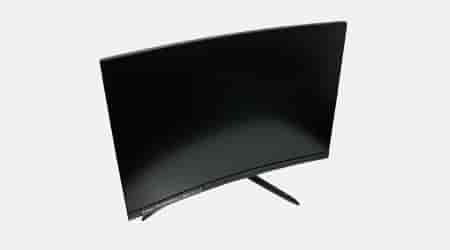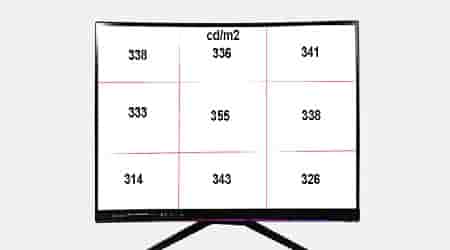Want to know about the best 144Hz gaming monitor? The MSI Optix MAG27CQ monitor is the best 144Hz gaming monitor. The monitor is discussed in detail in the MSI Optix MAG27CQ review, which will give you a clearer idea about this monitor.
MSI Optix MAG27CQ is the 2K curved monitor par excellence, a device presented at Computex 2019 and that we have already had on our test bench. This new Optix will not be the only one we test, but it will offer a very good quality/price judging by the previous model. It is a 27 ”curved monitor with a 2K resolution that reaches a frequency of 144Hz and 1 ms response thanks to a VA panel with very good performance.
MSI does not forget its aesthetic section and has included RGB lighting in front and behind and event management through the Smartphone.
We will see all this and more, but first, we must thank MSI for their trust in us and our work by temporarily releasing their product to us for analysis.
Table of Contents
MSI Optix MAG27CQ technical characteristics
MSI Full HD Gaming Red LED Non-Glare Super Narrow Bezel 1ms 2560 x 1440 144Hz Refresh Rate 2K Resolution Free Sync 27” Curved Gaming Monitor
Among its main features, We find
- Display Type: LED
- Screen Size: 27 inches
- Color: Black
- Aspect ratio: 16:9
- Resolution: QHD Wide 1440p
- Refresh Rate: 144hz
- Response Time: 1ms
- Weight: 10.78 lbs
- Dimensions: 24.1 x 8.09 x 17.09 inches
- Mounting Type: Wall Mount
- Viewing Angles: 178° wide
MSI Optix MAG27CQ Review about Unboxing
MSI Optix MAG27CQ is a monitor with contained dimensions and weight compared to other equipment. We notice this when taking your rigid cardboard box that in principle we should not have problems during its transport.
This box is the one that the manufacturer uses in all its models, completely printed in black with a photo of the monitor both in front and behind on its main faces. Similarly, we have information about the model we have in hand and its main technical characteristics on the sides.

The box is opened from the top, referring to the photo, and we will have to completely remove a case made up of two expanded polystyrene corks that house all the accessories and product inside.
In this case, they will be the following:
- Screen MSI Optix MAG27CQ
- Metal base
- Clamping arm
- Power supply (external)
- Screws for optional installations
- HDMI cable
- USB Type-B – Type-A data cable
- Splitter Jack for audio
- Manual
The monitor initially comes completely disassembled in three pieces, so we will have to put them together. This is as easy as screwing the legs to the arm using a pre-installed screw and then attaching the display to the arm with a two-tab system with lower fixation.
We do not have a DisplayPort cable available; it will not be strictly necessary either because both ports support the same resolution and speed.
Design
MSI Optix MAG27CQ review discusses the design of this monitor since we have to mount the MSI Optix MAG27CQ monitor, we will take the opportunity to see the support arm in detail. It comes in two pieces, which are metallic to support the weight of the screen. The support is based on two legs that take up a lot of space, as we can see, and a foot on the back quite discreet that allows the monitor to be glued to the wall, and that’s good.

The support arm has, as always, a hydraulic movement system to raise and lower the screen and a fairly strong grip that almost eliminates the wobbles of the screen. The visible area consists of a black hard plastic housing without integrated lighting. Finally, the screen clamping system is a custom VESA variant with two metal tabs on the top and a lower “click” that holds it. The monitor is, of course, compatible with the VESA 100 × 100 mm standard.
Distinguishing MSI’s Optix series monitors is the almost complete removal of their physical screen bezels. If you look at it, we only have a very small edge in the entire upper and lateral area, while below the minimum necessary 26 mm frame is kept to put the hardware. On the side and the top, the screen’s frames are generated with only 8 mm thick, thus reaching a useful surface greater than 90%.
This MSI Optix MAG27CQ is a monitor with 1800R curvature and 16: 9 aspect ratio on a 27-inch panel covered with very good diffusion anti-glare protection. MSI uses this type of configuration quite frequently on its gaming monitors to satisfy the needs of e-Sports. You know that screens of this size are the most used in this field, although not precisely those with curvature; that is why the manufacturer offers this type of options much more than its rivals.
If we look at the bottom frame, we have a total of 5 cells that generate RGB lighting compatible with Mystic Light. This time we can customize it with the SteelSeries GameSensesoftware, which we will see later. Of course, the general design is optimized so that a user can mount up to 3 simultaneous monitors oriented to simulators. Can manage the set in an integrated way with this software.
Focusing now on the rear of the monitor, we see a design very similar to the lower model; we are talking about the MSI Optix MPG27C; in fact, it is the same. So in the shiny plastic area, we will have the RGB lighting system with MSI’s technology and the same design simulating electrical tracks.
Ergonomics
MSI Optix MAG27CQ supports movement in the three axes of space. It allows the vertical movement of the screen in a range of 120 mm from the lowest to the highest position.
The clamping of the arm to the base allows the rotation in the Z-axis with 40 ° to the right and the left. Finally, the screen support will modify the front orientation at an angle of 5 ° downwards and 20 ° upwards.
Ports and connections

We see the panel of ports of the MSI Optix MAG27CQ, located in the lower area and the left side area seen from the front. That means that it is the same as the predecessor model, having:
- Jack type power connector
- 2x HDMI 2.0
- DisplayPort 1.2
- USB 3.0 Type-B port for data
- 2x USB 3.1 Gen1 (3.0) for storage devices
- 3.5mm jack connectors for separate audio and microphone
Separating the video and service ports from the USB is the best way to allow the user to insert flash drives in a comfortable situation seamlessly.
It is important to know that the versions of the video ports will support 2560x1440p resolution at 144 Hz without any problem. This means that we can use both indifferently to connect the monitor and work to the best of its possibilities. Also, remember that AMD FreeSync is compatible with DP and HDMI.
Screen and features
And if we talk about the benefits of the MSI Optix MAG27CQ, we will inevitably have to draw comparisons with its previous model, also analyzed by us and that you will have in this link.
And the main difference between both models lies in the resolution; in this case, we have 2560 x 1440p for the MSI Optix MAG27CQ compared to 1920x1080p for the MSI Optix MPG27C. We can say then that it is a variant that presents the same characteristics but increases its resolution.
This monitor then has 27 inches and a 16: 9 aspect ratio, which reduces the pixel pitch to only 0.2331 × 0.2331 mm, thus generating greater image clarity and increasing quality.
The maximum refresh rate MSI has chosen is 144 Hz, and the response is 1 ms on a 16.7 million colour VA-type panel, with 90% DCI-P3 and 115% sRGB. In addition, the manufacturer informs that the colour palette chosen for its calibration is that of the CIE 1976 standard, something to take into account in the calibration section.
The rest of the features offered by the panel are a contrast ratio of 3,000: 1 typical in this type of panel and 100,000,000: 1 in DCR. The brightness has also increased to 400 nits, compared to 250 that the Full HD model has, which is noticeable, and a lot.
Speaking of a gaming monitor, we cannot forget about its AMD FreenSync technology for dynamic refreshment and its compatibility with Nvidia G-Sync.
Remember that we must activate this capacity from the OSD panel. This VA panel offers us 178-degree viewing angles both horizontally and vertically. They are not as good as those of an IPS panel, especially due to the curvature, but the colour distortion is quite slight.
As MSI’s technologies, we have the Gaming OSD software, such as managing the image characteristics from the operating system and a new MSI Remote Display application to control our smartphone’s monitor. Nor could it miss the Anti-Flicker technology to reduce the amount of flickering and split-screen function and the crosshairs on the screen to improve the gaming experience in FPS.
Along the way, for example, HDR content support or a better Delta calibration, as we will see later, has remained. That is why the strong point of the monitor will be its quality/price ratio. Among interesting features, we have the design-oriented PIP and PBP function.
The HDCR function adapts the brightness level to what is shown in the image, or the black level adjustment to improve the image in very dark scenes.
Color testing and calibration
We continue with the calibration section for this MSI Optix MAG27CQ. We will see the monitor’s colour characteristics, evaluating the calibration available from the factory and the brightness capacity. To do this, we will use the X-Rite Colormunki Display calorimeter together with our calibration software for its adjustment and the free HCFR software to monitor the colour characteristics.
As always, we are going to extract the results in the sRGB and DCI-P3 colour spaces. In this case, we must bear in mind that the colour palette used to calibrate the monitor corresponds to CIE1976, while we will use the CIE2000 palette so the Delta E will be affected as normal.
Brightness and Contrast
We have first proceeded to measure the actual brightness and contrast characteristics of the monitor. Due to its size, we have divided the panel into a 3 × 3 grid to see its maximum brightness, which should be 400 nits.

In this case, we see that at no time is reaching the 400 nits that appear in the specifications. The highest result obtained is in the centre of the screen with 355 cd / m 2, while at the edges, we are closer to 300 than 400 nits.
And when it comes to contrast, we’ve got 2000: 1 ratio, which also leaves that 3000: 1 out of your specs—being able to determine then that the panel does not reach its maximum records, at least in this unit of analysis.
SRGB color space
Here is what we were saying about the checked colour palette, whose calibration delta is far from ideal due to what has already been saying. As far as graphics are concerned, the truth is that we do not have some that are too adjusted to what is considered ideal for the colour space but could improve it by doing a calibration. We have obtained the most adjusted values with a brightness of 60%.
What is perfectly reflected is that we are exceeding the sRGB colour space by a fairly large percentage; 115% is what MSI specifies. We see that the colours perfectly comply with this space in the three vertices, and we should only improve point D65 to adjust the panel’s colour temperature.
DCI-P3 color space
In this section, more or less the same happens, all the graphs being relatively far from what the program considers ideal. If we look at the CIE diagram, we see that the colors of the lower vertices are perfectly adjusted to what the space demands and the only thing missing is an improvement in the level of greens. Thus determining that 90% shown in the panel specifications.
Lighting and software
Before telling our experience of using MSI Optix MAG27CQ, it is good to know that we can improve it substantially thanks to the multiple support programs that MSI includes for this monitor.
But first of all, we must connect the USB cable of the monitor to our equipment to obtain this communication capacity between the system and the equipment. Similarly, we will need to install the monitor driver, which is available on the MSI product support page, whose instructions are included in a PDF.
The first important program will be SteelSeries GameSense, which will allow us, among other things, to manage in an advanced way the double addressable lighting system of the monitor. We can also install MSI Mystic Light so that this system is synchronized with our MSI ecosystem.
MSI Gaming OSD will already know many of you because we have seen it in other monitors analyzed. With this program, we will expand the characteristics of the OSD panel, being able to customize the image output in up to 8 different modes shown in the left list. We will have a series of advanced tools to customize the split-screen mode and monitor interaction options in the right area.
If we go to the options wheel, we will find some of the OSD panel, such as the input signal selection, OSD layout and the possibility of creating macros for other functions or hotkeys.
And finally, we will have the MSI Remote Display application available on Android, which we can download from Google Play for free. This application requires that the equipment with the monitor be connected to the same network as the mobile. , we can locate the equipment and monitor to modify many options of its OSD in real-time. The truth is that it is very interesting and useful for those of you who like to be interconnected with your devices. We highly recommend it.
Use experience
As I usually do, I will tell my experience of using this MSI Optix MAG27CQ in the three clearest application sections.
Multimedia and cinema
In this aspect, we have a more or less standard performance monitor in terms of image capacity. I say this because we do not have HDR technology or an ultra-wide design that takes advantage of the 21: 9 content used in the cinema.
On the other hand, it is a fairly large screen, 27 inches with 2K resolution, so the playback and rescaling of movies in both 1080p and 4K will be very good for being halfway there. The immersion that its curvature gives us also favours us to immerse ourselves more in what we see from my perspective. So the less, it meets the expectations.
Gaming
It is obvious what MSI presents this team to us. After the successful MSI Optix MPG27C, it has now wanted to launch this new model with a 2K resolution and identical format to reach the market of professional gamers who already move at these levels. And it is that it combines practically all the qualities of good gaming, a versatile panel with excellent viewing angles, a frequency of 144 Hz with FreeSync and 1 ms of response.
In addition, I see it very logical to implement this resolution since there are quite a few graphic cards on the market that handles perfectly in these resolutions with FPS higher than 100, see the new RTX Super or the RX 5700. In this way, it is possible to satisfy needs -Sport rescaled to 1080p without sacrificing speed or placing 2K to enjoy a good RPG with peace of mind. And it is that 2K will be more and more the optimal resolution to play, at least in campaign mode.
Then we must consider the possibilities that it does not offer in terms of lighting or its 16: 9 curved configuration that allows better immersion without giving up having everything under the control of our eyes. Applications such as OSD in the system or remote configuration increase the versatility of this monitor. You can activate the HDCR, which will help optimise the panel’s brightness in front of dark and very light scenes so that we never miss a detail.
Design
In this last section, I do not consider that it is a recommended monitor for professional design, although it is true that having a 2K resolution increases its possibilities. But we are not having a Delta E <2 calibration or X-Rite certification is something a professional designer needs. We know spectacular VA panels on the market, although in this case, we need an extra feature that this monitor does not provide.
OSD panel
As a prelude to the end of our review, we find an OSD menu as complete as other MSI equipment. We can even manage the monitor lighting from here, although only in a basic way.
To control it, we only use a joystick with a central button to move it through all the options in the four directions of space. Without a doubt, the easiest, most intuitive and fastest method that a monitor can have. Fortunately, practically all the new models use it.
This menu has one more section than the 1080p model, being that of PIP and PBP as panel division modes; for the rest of the details, it is practically the same with the same options. Similarly, we have four quick menus that we can open in the four directions of the joystick to configure an alarm, select input signal, image mode and activation the crosshairs on the screen.
Final words and conclusion about MSI Optix MAG27CQ
As we said on the day of the Optix MAG27CQ review, this model inherits many things from the previous model, especially in regards to design. And we have a model that is practically the same, the same materials, the same screen and support design and the same lighting system.
We have obvious improvements in the image quality since its resolution has been increased to 2560x1440p and 400 nits, although it does not reach them. This will allow us to stretch much more in the graphic quality when we are playing in campaign mode, where the game experience will be much better than in full HD.
Despite this increase in resolution, the maximum frequency of 144 Hz, AMD FreeSync and the response time of 1 ms is still maintained, being exactly as fast as the lower model, so also for e-Sports, it is a great option. One of the weak points could be the colour calibration since it is not very good for design. Still, neither the brightness nor the contrast reaches the theoretical parameters, staying at 355 nits and 2000: 1, respectively.
Another of its strengths is its ability to manage the programs we have seen and the great novelty of integrating it with our Smartphone through MSI Remote Display, which, on the other hand, works like a charm. Its OSD panel remains as complete as ever with everything you need.
With this, MSI Optix MAG27CQ is emerging as a very attractive option for its general image quality, ignoring the details discussed for its gaming design and price. It is available at a reasonable price, so it’s quality/price ratio is undeniable—a great job from MSI on this Optix.
Advantage
- Management by software.
- AMD FreeSync and 144hz on a 2k panel.
- APP for a smartphone.
- Combination of curvature and 16:9 ratio for sports.
- Excellent quality/Price ratio
Disadvantages
- It does not have HDR.
- Your calibration is not optimal.
Read More: MSI Optix MPG341CQR Review And: Asus XG27VQ Review


